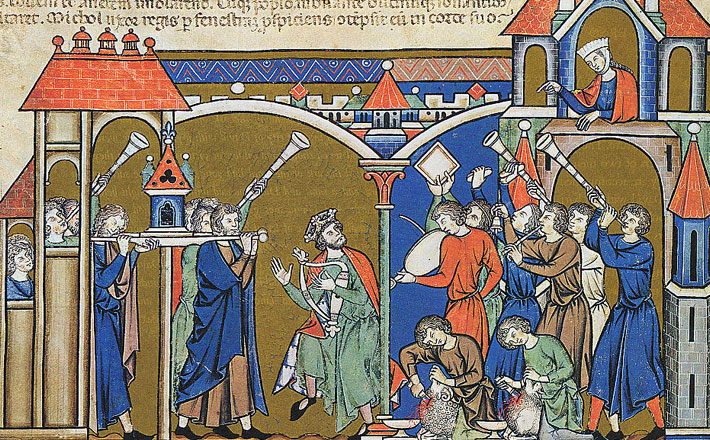Commentary on John 3:14-21
Ask someone on the street to quote a Bible verse, any Bible verse, and you may get a blank stare.
But ask them to name a Bible verse and you are in business: John 3:16. It’s the perfect verse to plaster on a bumper, or brandish on a sign at a football game. John 3:16 has become a kind of trademark for evangelical Christians — a way to reduce and simplify one version of the Christian gospel to a quick sound bite.
In one sense, this use is justified. Following the dialogue between Jesus and Nicodemus (John 3:1-10), verse 16 does fall within a discourse (3:11-21) in which Jesus offers a kind of summation of God’s good purposes for the world. Jesus’ speech takes the form of second order reflection upon the meaning of his own life, so much so that interpreters have debated whether these verses are best understood as the words of a character within the story, or as an aside in which the narrator addresses the reader directly. On balance, it is probably best to take these verses as depicting the words of Jesus, yet the “meta” character of this discourse is striking — here we see Jesus offering a Christological reflection on himself.
But if it is true that these verses zoom out to address the big picture of God’s work in Christ, it is not true that the message is simple, nor can verse 16 be understood well as an abstract slogan, apart from its immediate context within John. In the first place, the context suggests that the truth about God’s purposes in Christ is confusing and troubling, not obvious and cross-stitch-worthy. Nicodemus finds this Good News confusing (John 3:10) because it demands that he let go of all that he has accomplished and understood — let go and become like a newborn, ready to receive the world on completely new terms. There is an ethical dimension to understanding. Some things are hard to grasp not because they are conceptually subtle, but because they ask so much of us. We don’t want to understand, because if we understand, we are implicated.
God loved the world so much that God gave the Son so that we may believe and have eternal life (John 3:16). What is it about this “simple” Good News that we don’t want to understand?
In the first place, we must contend with the peculiar and troubling image Jesus has chosen to describe himself: he says that he is like the serpent that Moses lifted up in the wilderness (John 3:14, see Numbers 21:9). In the story from Numbers, God sent poisonous serpents into the Israelite camp as punishment for the people complaining against God. When the people repented, God told Moses to fashion a serpent out of bronze and lift it on a pole, so that anyone bitten by a serpent could look upon it and live. In the same way that the serpent was lifted on a pole, “so must the Son of Man be lifted up” (John 3:15). The term translated “lift up” (hypsoo) can also mean “exalt,” and John uses that double meaning to communicate a theological paradox. It points to both the physical lifting of Jesus into the air on a cross, and the lifting up in exaltation of Jesus by God (see also John 8:28, and John 12:32). In terms of human agency, of course, the cross is a moment of profound humiliation and defeat. But in John’s theological imagination, crucifixion, resurrection, and ascension are collapsed into a single movement of divine agency: Jesus exalted by God. Just as the Israelites were paradoxically required to look upon the very thing that brought death in order to receive life, so we are asked to look upon Jesus’ “lifting up” in humiliating crucifixion and receive it as part of God’s plan to glorify Jesus and save the world. The image of Jesus as the serpent “lifted up” is paradoxical, not simple.
What does it mean to “believe” this Good News that in Jesus “lifted up” God seeks the world’s salvation, and not condemnation (John 3:17)? Simplistically, we might say that it requires us to offer our intellectual assent to the proposition that all of this happened in just the way the story describes, and to accept that it means precisely what John claims that it means. To “believe that” Jesus died and was raised to save us is easy to understand in the sense that it requires almost nothing of us. But such simplicity does not honor the larger story John is telling. This is a story about an encounter with Jesus that left an intelligent and accomplished man scratching his head in bewilderment as he went back out into the darkness. This is a story about how any one of us might reject the light offered to us because of the way it exposes what is dark in us (John 3:19–20). To “believe” this Good News in a way that brings salvation requires more than “believing that;” it requires “trusting in.” To “trust in” Jesus is not simply to believe something about what happened long ago, but also to let our own lives be transformed by the Jesus we encounter in this story:
1) Placing our trust in this Jesus means withholding our ultimate loyalty and trust from other things that ask us to pledge our allegiance. Remembering that he was publicly executed as an enemy of empire, we must be honest with ourselves about the subtle ways we are complicit in and benefit from imperial coercion. The “lifting up” of Jesus on a Roman cross places ever before us the question of who we will serve.
2) Placing our trust in this Jesus means noticing that the new life Jesus offered was especially difficult for the religiously accomplished. We must repent of the ways our self-satisfied religiosity becomes a barrier to understanding the new things Jesus offers and asks of us. The “lifting up” of Jesus is a stumbling block for those obsessed with decorum and conformity to tradition.
3) Placing our trust in this Jesus means confronting the inconvenient truth that God’s purposes for those God loves are not synonymous with our own common-sense values of happiness, health, and safety. The trail of faith that Jesus blazed reveals that, while there is nothing in this world worth killing for, there are things worth dying for. The “lifting up” of Jesus reminds us that the true life God has promised us is not the life that we can secure for ourselves through self-interest and caution.


March 15, 2015